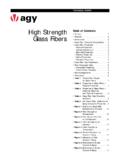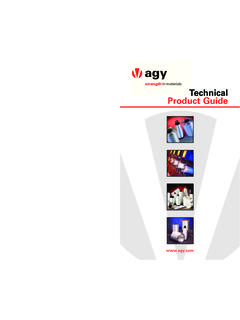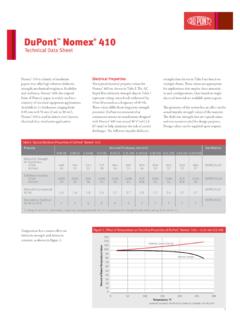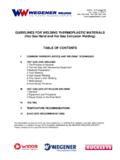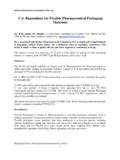Transcription of High Strength - AGY
1 TECHNICAL PAPER Authors ..2 Abstract ..2 Introduction ..2 Glass Fiber Chemical Compositions ..2 Glass Fiber Properties ..3 Physical Properties ..3 Chemical Resistance ..3 Electrical Properties ..3 Thermal Properties ..4 Optical Properties ..5 Radiation Properties ..5 Glass Fiber Size Treatments ..5 Fiber Composite Utility ..5 Composite Properties ..5 Environmental Durability ..5 Acknowledgements ..6 References ..6 Table 1 Composition Ranges for Glass Fibers ..7 Table 2 Properties of Glass Fibers --Physical Properties ..7 Table 3 Properties of Glass Fibers --Chemical, Electricaland Thermal Properties ..8 Table 4 Glass Fiber Size ChemistrySummary.
2 9 Table 5S-2 Glass Fiber UnidirectionalEpoxy Composite Properties .9 Figure 1 Continuous Glass FiberManufacturing Process ..10 Figure 2 Fiber Strength at Temperature ..10 Figure 3 Fiber Weight Retention vs. pH Exposure ..10 Figure 4 Fiber Strength vs. pH Exposure ..11 Figure 5 Glass Viscosity ..11 Figure 6 Thermal Expansion In Epoxy ..11 Figure 7 Dielectric vs. Fiber Volume In Epoxy ..11 Figure 8 Environmental Stress Rupture In Epoxy ..11 Figure 9 Environmental Stress Rupture In Epoxy ..11 Table of ContentsHigh Strength Glass FibersHigh Strength Glass FibersAuthorsIn 1996 this paper was written incollaboration with David Hartman,Mark E. Greenwood, and David who were employed at thetime by Owens Corning Corp.
3 Mr. Hartman received his degree in chemistry from David LipscombUniversity and an degree inchemistry from Georgia Institute ofTechnology with emphasis in textileand plastic engineering. Mr. Greenwood received his and degrees in Civil Engineeringfrom Purdue University, with anemphasis in structural design. Dr. Miller received his Bachelor s,Master s, and degrees inCeramic Engineering from the Ohio State glass fibers, first conceived and manufactured during1935 in Newark, Ohio, started arevolution in reinforced compositematerials which by 2000 led to aglobal annual glass fiber consump-tion of million tons. During 1942glass fiber reinforced compositeswere first used in structuralaerospace parts.
4 In the early 1960 shigh Strength glass fibers, S Glass,were first used in joint work betweenOwens Corning Textile Products andthe United States Air Force. Later in 1968 S-2 Glass fibers beganevolving into a variety of commercialapplications. high Strength glassfibers combine high temperaturedurability, stability, transparency, and resilience at a very reasonablecost-weight-performance. The utilityof high Strength glass fiber composi-tions are compared by physical,mechanical, electrical, thermal,acoustical, optical, and :S-2 Glass; C Glass,AR Glass, D Glass, ECRGLAS, R Glass; E Glass; Fiberglass, IntroductionAncient Egyptians made containersof coarse fibers drawn from heatsoftened glass.
5 The French scientist,Reaumur, considered the potential of forming fine glass fibers for wovenglass articles as early as the 18thcentury. Continuous glass fiberswere first manufactured in substan-tial quantities by Owens CorningTextile Products in the 1930 s forhigh temperature electrical applica-tions. Revolutionary and evolutionarytechnology continues to improvemanufacturing processes for continuous glass fiber production,illustrated in Figure 1. Raw materialssuch as silicates, soda, clay, limestone, boric acid, fluorspar orvarious metallic oxides are blendedto form a glass batch which is melt-ed in a furnace and refined duringlateral flow to the forehearth. Themolten glass flows to platinum/rhodium alloy bushings and thenthrough individual bushing tips andorifices ranging from to ( to in) and israpidly quenched and attenuated in air (to prevent crystallization) intofine fibers ranging from 3 to 35 winders pull the fibers at lineal velocities up to 61 m/s overan applicator which coats the fiberswith an appropriate chemical sizingto aid further processing and performance of the end Strength glass fibers like S-2 Glassare compositions of aluminosilicates attenuated at highertemperatures into fine fibers rangingfrom 5 to 24 m.
6 Several othertypes of silicate glass fibers are manufactured for the textile andcomposite industry. Various glasschemical compositions describedbelow from ASTM C 162 were devel-oped to provide combinations of fiberproperties directed at specific enduse GLASS Soda lime silicate glassesused where the Strength , durability,and good electrical resistivity of E Glass are not GLASS Calcium borosilicateglasses used for their chemical sta-bility in corrosive acid GLASS Borosilicate glasses witha low dielectric constant for electri-cal GLASS Alumina-calcium-borosili-cate glasses with a maximum alkalicontent of 2 used as generalpurpose fibers where Strength andhigh electrical resistivity are Calcium aluminosilicateglasses with a maximum alkali con-tent of 2 used where Strength ,electrical resistivity.
7 And acid corrosion resistance are GLASS Alkali resistant glassescomposed of alkali zirconium silicatesused in cement substrates and GLASS Calcium aluminosilicateglasses used for reinforcementwhere added Strength and acid corrosion resistance are GLASS Magnesium aluminosil-icate glasses used for textile substrates or reinforcement in composite structural applicationswhich require high Strength , modulus, and stability under extremetemperature and corrosive Glass Fiber ChemicalCompositionsChemical composition variation within a glass type is fromdifferences in the available glassbatch raw materials, or in the melting and forming processes, or from different environmental con-straints at the manufacturing compositional fluctuations donot significantly alter the physical orchemical properties of the glasstype.
8 Very tight control is maintainedwithin a given production facility toachieve consistency in the glasscomposition for production capabilityand efficiency. Table 1 provides the2oxide components and their weightranges for eight types of commercialglass fibers [1-6].3. Glass Fiber PropertiesGlass fiber properties, such as tensile Strength , Young s modulus,and chemical durability, aremeasured on the fibers properties, such as dielectricconstant, dissipation factor, dielectricstrength, volume/surface resistivi-ties, and thermal expansion, aremeasured on glass that has beenformed into a bulk sample andannealed (heat treated) to relieveforming stresses. Properties suchas density and refractive index aremeasured on both fibers and bulksamples, in annealed or unannealedform.
9 The properties presented inTables 2 and 3 are representative ofthe compositional ranges in Table 1and correspond to the followingoverview of glass fiber Physical Properties Densityof glass fibers is measured andreported either as formed or as bulkannealed samples. ASTM C 693 isone of the test methods used fordensity determinations [7]. The fiberdensity (in Table 3) is less than thebulk annealed value by g/cc at room glass fiber densities used incomposites range from approximate-ly g/cc for D Glass to for Strength of glass fibers is usually reported as the pristinesingle-filament or the multifilamentstrand measured in air at room tem-peratures. The respective strandstrengths are normally 20 to 30%lower than the values reported inTable 2 due to surface defects intro-duced during the strand-formingprocess.
10 Moisture has a detrimentaleffect on the pristine Strength ofglass. This is best illustrated by measuring the pristine single-filamentstrength at liquid nitrogen tempera-tures where the influence ofmoisture is minimized. The result is an increase of 50 to 100% instrength over a measurement atroom temperature in 50% relativehumidity air. The maximummeasured Strength of S-2 Glassfibers at liquid nitrogen temperaturesis GPa for a mm gaugelength, 10 m diameter fiber. Theloss in Strength of glass exposed tomoisture while under an externalload is known as static fatigue [ ].The pristine Strength of glass fibersdecreases as the fibers are exposedto increasing temperature. E Glassand S-2 Glassfibers have beenfound to retain approximately 50% of their pristine room-temperaturestrength at 538 C (1000 F) and arecompared to organic reinforcementfibers in Figure Young s modulus of elasticityof unannealed silicate glass fibersranges from about 52 GPa to 87 GPa.
